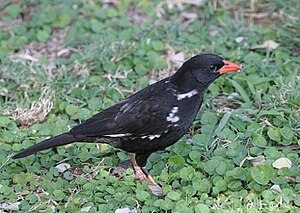Buffalo weaver
| Buffalo weaver | ||||||||||||
|---|---|---|---|---|---|---|---|---|---|---|---|---|

Buffalo weaver ( Bubalornis niger ) |
||||||||||||
| Systematics | ||||||||||||
|
||||||||||||
| Scientific name | ||||||||||||
| Bubalornis niger | ||||||||||||
| Smith , 1836 |
The buffalo weaver ( Bubalornis niger ) is a species of bird of the genus Bubalornis from the family of weaver birds (Ploceidae) and is native to the thornbush steppes of East Africa.
There are two subspecies. The IUCN classifies the buffalo weaver as not endangered ( least concern ).
Appearance
With a body length of 24 cm and a body mass of 65 g, it is one of the largest representatives of the weaver birds. The sexual dimorphism is not very pronounced.
The male's plumage is dark chocolate brown. The feathers on the front wing-coverts and wings are lined with white, the beak is reddish-brown, the eyes are brown and the feet are reddish-brown. The females are monochrome, dark chocolate brown on the upper side of the body, and the feathers on the chin and throat have wide white borders. The flanks, the belly and the thighs as well as the under tail coverts are also dark brown. The beak is dark horn-colored in the females, the eyes dark brown and the legs light brown. Young birds are pale brown, the underside of their bodies is spotted white, the beak is orange-yellow to light reddish.
The buffalo weaver differs from the Alektoweber ( Bubalornis albirostris ), which belongs to the same genus, by its beak color .
Distribution area and habitat
The buffalo weaver is endemic to southern Africa, the distribution area is not contiguous, in the Republic of South Africa, for example, it occurs on high plateaus, but it is absent in the lowlands. The African countries in which it occurs include the Republic of South Africa, Angola , Botswana , Ethiopia , Kenya , Mozambique , Namibia , Rwanda , Somalia , Sudan , Swaziland , Tanzania , Uganda , Zambia and Zimbabwe .
The habitat of the buffalo weaver is the dry savannah, it occurs among other things in the mopane and in light forests consisting of acacias and baobabs at altitudes of less than 1,500 meters. It needs large trees to plant its nests, which explains the patchy occurrence in some regions.
It is a resident bird in large parts of its distribution area, but seasonal migrations occur in some regions. It is absent from the Kruger National Park during the dry season and does not return to this South African national park until October.
Way of life
Buffalo weavers feed on seeds , insects, and fruits . He looks for his food mainly on the ground. He moves there running and hopping. Non-breeding buffalo weavers form groups of up to 50 individuals. In southern Africa it is often associated with other bird species such as lobster star , green-tailed gloss star , meves gloss star , giant gloss star , white flank bat , mourning drongo , red rein Sylvietta and damara sparrow. In Somali the troops are smaller in the winter months and comprise only twenty to thirty individuals. Here the troops are often socialized with the star weaver and the three-color gloss star, and occasionally with the golden beak. In Kenya, groups of buffalo weavers are accompanied by the long-tailed shrike.
Their predators include eagles , marabou and snakes . Nestlings are particularly threatened during the breeding season. Narrow tubular entry holes on the underside of the community nest built in the treetops are intended to make entry difficult for enemies.
A clutch consists of three to four eggs.
nest
Buffalo-weavers build community nests that are divided into individual nesting chambers. A nest is sometimes inhabited by several hundred birds. The dwelling, built exclusively by the males, from dry grass and brushwood, can reach a height of about three meters and a width of about 4.50 m. It happens that trees collapse under the weight of such a huge nest. The nest is used for several years and is constantly being expanded and repaired.
sexuality
Both sexes have a genital opening that they press against each other during the mating act. In addition to the sexual opening , the male has a phalloid organ made of connective tissue, which, however, does not serve to transmit sperm . During the relatively long mating process (approx. 30 minutes), the male rubs this pseudophallus on the genitals of the female before it ejaculates from its sexual opening . During ejaculation, the male's whole body shakes and twitches, suggesting that he is experiencing an intense orgasm .
Buffalo weavers - both males and females - each have several sexual partners. As with many promiscuous bird species, the female is able to excrete the sperm after mating and thus enable a subsequent applicant to fertilize, should she prefer it. It is believed that the genital stimulation of the female has an influence on this preference and the genetic selection associated with it.
literature
- C. Hilary Fry and Stuart Keith (Eds.): The Birds of Africa. Volume VII. Christopher Helm, London 2004, ISBN 0-7136-6531-9 .
- Olivia Judson: The refined sex practices of animals , Heyne, 2006, ISBN 3-453-60014-2
- Michael Miersch: The bizarre sex life of animals , paperback, Piper, October 2002, ISBN 3-492-23795-9 , excerpt with passage on the sexuality of buffalo weavers on zeit.de: zoology: The great pairing
Individual evidence
Web links
- www.uni-heidelberg.de
- www.nature.com
- Videos, photos and sound recordings of Bubalornis niger in the Internet Bird Collection
- Bubalornis niger inthe IUCN Red List of Threatened Species 2013.2. Listed by: BirdLife International, 2012. Retrieved January 29, 2014.
